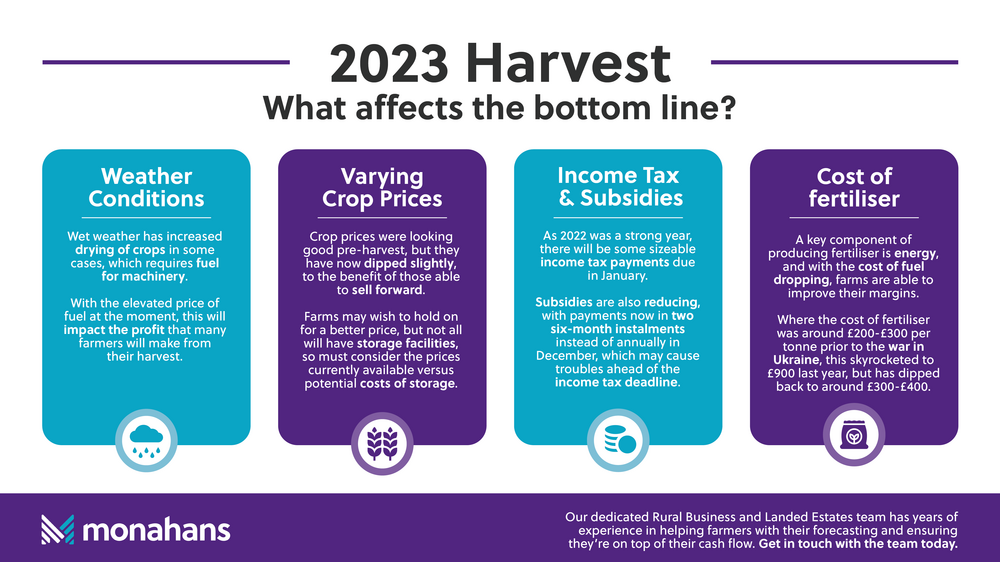18 Sep 2023
Harvest 2023 v 2022: a look at the farming sector

As we approach the end of the questionable British summer, the farming sector is ruing a miserable bout of weather and the adverse effects it has had on the harvest season, compared to 2022’s bumper harvest.
Generally speaking, the wet conditions made it more difficult to get machinery through the crops, though some had less of an issue with this, with much depending on the locality of the poor weather. Fortunately, the yield – the amount of crop that comes from the harvest – seems to have been in line with the last few years.
Reasonably good news, then? Well, not terrible, but further issues have arisen with the inclement conditions requiring that crops be dried prior to sale, which is an additional cost to farmers. This involves running the crops through machinery, which smaller farms may have to rent, and the additional cost of the fuel – usually gas or diesel – to do so. With the elevated price of fuel at the moment, albeit lower than it has been in recent months, this will impact the profit that many farmers will make from their harvest.
Of course, this is offset by a number of our clients having to do little to no drying, and it is the plight of the sector that a lot of timing is based on luck, rather than strategy. As much as a farmer can plant his or her seeds in a certain week and plan ahead according to the crop’s cycle – spring season or autumn season – if it pours with rain, as it did throughout most of August, they will feel the impact. Added to this is the fact that many smaller farms employ contractors to undertake their harvesting, also hiring the machinery, so they have less control over when the work can be done.
Prior to the harvest, crop prices were looking pretty good, although there has been a slight dip in what farmers are being offered, meaning that those who were able to sell forward will have benefitted. This is when farmers agree a price in advance, based on an assumed quantity, say 500 tonnes for X pounds per tonne. How much they’ve been able to agree at this price is another element that will affect the bottom line. Indeed, income from selling forward is often used to pay for input costs like fertiliser and then the balance of the harvest is the profit – but that’s variable.
Equally, farms may wish to hold on for a better price, but not all will have storage facilities, so there’s a weigh up as to the prices currently available on the market versus potential costs of storage.
This is where working with an accountancy firm can be of benefit in terms of helping farmers with their forecasting and ensuring they’re on top of their cash flow. We are starting to do the March 2023 accounts for our clients and, with a strong year in 2022, there will be some sizeable income tax payments due in January. A weaker harvest this time around may well cause some cashflow squeezes, while there are also government changes to subsidies to consider. It has been well documented that these are tapering away and to complicate matters, where payments were previously made annually – in December, ahead of income tax payments being due – these are now paid in two six-month instalments. This means that farmers will receive less at the end of the year, which may cause further troubles ahead of the income tax deadline.
That may seem overly pessimistic, but it’s not; there are plenty of positives. For example, the premiums for milling – the process of grinding grain so that it can be turned into bread or beer – are high, and the cost of fertiliser, certainly compared to last year, is low. A key component of producing fertiliser is energy, and with the cost of fuel dropping, albeit not to where it was historically, farms are able to improve their margins. Specifically, where the cost of fertiliser was around £200-£300 per tonne prior to the war in Ukraine, this skyrocketed to £900 last year, but has dipped back to around £300-£400.
While there’s an element of luck to the harvesting element, as discussed, farms and agricultural businesses can make the most of these positives to overcome variables in the coming months. Preparation is key, though; getting on top of finances will help with forecasting and if you would like help from an accountant, there’s no time like the present to make enquiries. Getting records to an accountant early can give them an idea of tax due, for example, so that you can plan cashflow and expenditure around this.
Our dedicated Rural Business and Landed Estates team has years of experience in helping businesses make hay while the sun shines, and even thrive when it doesn’t. For an accountancy service that is specifically tailored to your needs and strives to translate numbers into meaning, get in touch with the team today.
Andrew Perrott